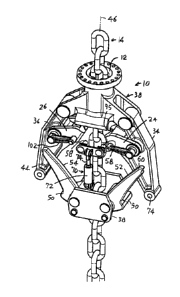Some of the information on this Web page has been provided by external sources. The Government of Canada is not responsible for the accuracy, reliability or currency of the information supplied by external sources. Users wishing to rely upon this information should consult directly with the source of the information. Content provided by external sources is not subject to official languages, privacy and accessibility requirements.
Any discrepancies in the text and image of the Claims and Abstract are due to differing posting times. Text of the Claims and Abstract are posted:
| (12) Patent: | (11) CA 2865128 |
|---|---|
| (54) English Title: | CHAIN CONNECTOR |
| (54) French Title: | CONNECTEUR DE CHAINE |
| Status: | Deemed expired |
| (51) International Patent Classification (IPC): |
|
|---|---|
| (72) Inventors : |
|
| (73) Owners : |
|
| (71) Applicants : |
|
| (74) Agent: | GOWLING WLG (CANADA) LLP |
| (74) Associate agent: | |
| (45) Issued: | 2019-07-02 |
| (86) PCT Filing Date: | 2013-01-23 |
| (87) Open to Public Inspection: | 2013-08-29 |
| Examination requested: | 2018-01-05 |
| Availability of licence: | N/A |
| (25) Language of filing: | English |
| Patent Cooperation Treaty (PCT): | Yes |
|---|---|
| (86) PCT Filing Number: | PCT/IB2013/000082 |
| (87) International Publication Number: | WO2013/124717 |
| (85) National Entry: | 2014-08-20 |
| (30) Application Priority Data: | |||||||||
|---|---|---|---|---|---|---|---|---|---|
|
A chain connector for holding a chain (14) that moors a vessel to the sea floor under perhaps 2000 tons tension, which can be quickly disconnected in an emergency by applying a moderate disconnecting force such as 50 tons. The chain is held by ratchets (24, 26) that are mounted on arms (34, 36). The arms have upper ends (35) that are pivotally mounted on a housing (38) and have free lower ends (44), with the lower ends being held by cams (50) on locking dogs (52) that have locking dog lower ends (51) pivotally mounted on the housing and free upper ends (60). A hydraulic actuator (70) has pins (58) that engage the upper ends of the locking dogs to prevent the arms and dogs from pivoting apart until the locking dog upper ends (60) are raised.
Connecteur de chaîne servant à maintenir une chaîne (14) pouvant amarrer un vaisseau jusqu'au fond de la mer sous éventuellement 2 000 tonnes de tension, qui peut être rapidement déconnecté en cas d'urgence par l'application d'une force de déconnexion modérée, par exemple 50 tonnes. La chaîne est maintenue par des rochets (24, 26) qui sont montés sur des bras (34, 36). Les bras ont des extrémités supérieures (35) qui sont montées de manière pivotante sur un logement (38) et ont des extrémités inférieures libres (44), maintenues par des cames (50) sur des griffes de blocage (52) dont les extrémités inférieures (51) sont montées de manière pivotante sur le logement et dont les extrémités supérieures (60) sont libres. Un actionneur hydraulique (70) possède des axes (58) qui viennent en prise avec les extrémités supérieures des griffes de verrouillage pour empêcher l'écart de pivotement entre les bras et les griffes jusqu'à ce que les extrémités supérieures de la griffe de blocage (60) soient levées.
Note: Claims are shown in the official language in which they were submitted.
Note: Descriptions are shown in the official language in which they were submitted.

For a clearer understanding of the status of the application/patent presented on this page, the site Disclaimer , as well as the definitions for Patent , Administrative Status , Maintenance Fee and Payment History should be consulted.
| Title | Date |
|---|---|
| Forecasted Issue Date | 2019-07-02 |
| (86) PCT Filing Date | 2013-01-23 |
| (87) PCT Publication Date | 2013-08-29 |
| (85) National Entry | 2014-08-20 |
| Examination Requested | 2018-01-05 |
| (45) Issued | 2019-07-02 |
| Deemed Expired | 2021-01-25 |
There is no abandonment history.
| Fee Type | Anniversary Year | Due Date | Amount Paid | Paid Date |
|---|---|---|---|---|
| Application Fee | $400.00 | 2014-08-20 | ||
| Maintenance Fee - Application - New Act | 2 | 2015-01-23 | $100.00 | 2014-08-20 |
| Registration of a document - section 124 | $100.00 | 2014-10-17 | ||
| Registration of a document - section 124 | $100.00 | 2014-10-17 | ||
| Maintenance Fee - Application - New Act | 3 | 2016-01-25 | $100.00 | 2015-12-17 |
| Maintenance Fee - Application - New Act | 4 | 2017-01-23 | $100.00 | 2017-01-09 |
| Request for Examination | $800.00 | 2018-01-05 | ||
| Maintenance Fee - Application - New Act | 5 | 2018-01-23 | $200.00 | 2018-01-09 |
| Maintenance Fee - Application - New Act | 6 | 2019-01-23 | $200.00 | 2019-01-08 |
| Final Fee | $300.00 | 2019-05-15 | ||
| Maintenance Fee - Patent - New Act | 7 | 2020-01-23 | $200.00 | 2020-01-03 |
Note: Records showing the ownership history in alphabetical order.
| Current Owners on Record |
|---|
| SINGLE BUOY MOORINGS, INC. |
| Past Owners on Record |
|---|
| None |